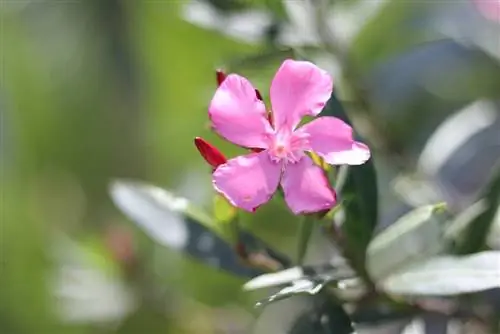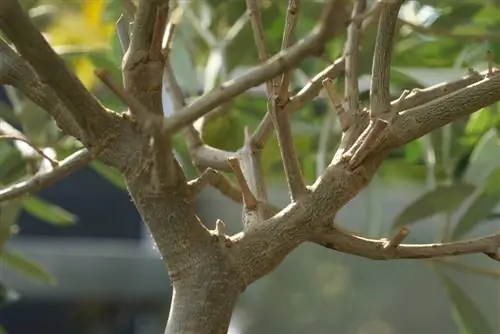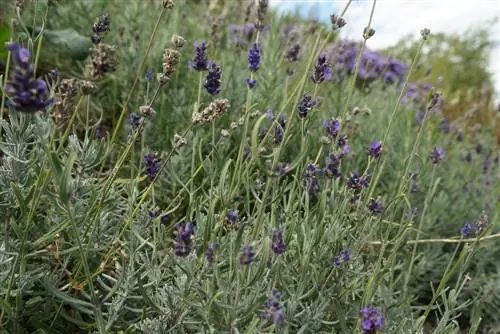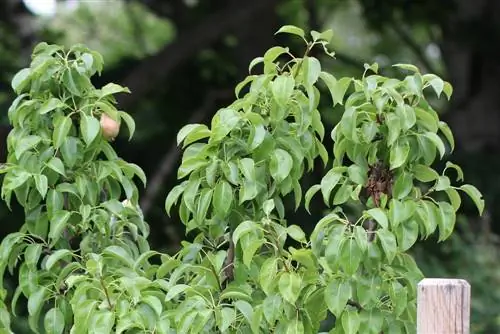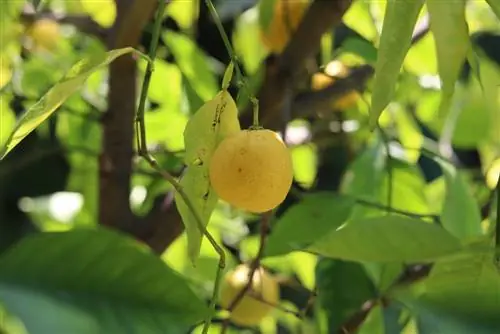- Author admin [email protected].
- Public 2023-12-17 03:39.
- Last modified 2025-06-01 06:48.
Graceful, colorful and exuding an intoxicating scent - the oleander is one of the most popular ornamental plants and never fails to delight hobby gardeners. But when the flowering period of the popular southerner comes to an end towards the end of September, the crucial question arises: How is the plant properly overwintered? If you take the plant's most important needs into account, you can also enjoy the lush and colorful flowers of the Mediterranean plant the following year.
Sensitive southerner - conditionally hardy
As a Mediterranean plant that is widespread throughout the Mediterranean region and also occurs in its natural form in parts of Morocco, southern Spain, parts of China and India, the oleander loves warm temperatures. Nevertheless, the plant is considered robust and can tolerate light frosts; Because it is partially hardy, but not completely winter-proof, the southern plant can withstand temperatures down to minus 5°C without being damaged. If you want to overwinter, you should always take the following points into account:
- depending on the location, the choice of indoor or outdoor accommodation
- the right lighting
- the optimal temperature
- comprehensive care measures
- the right time to end hibernation
Making preparations for the cold season
If you want to successfully get your oleander, which is not completely winter-proof, through the cold season, you should first take a few measures to make the plant more resilient. Cleaning out the plant is particularly important; Old, dead flowers and leaves are removed, which could have a negative impact on successful overwintering. In this context, the surface of the root ball should also be freed from weeds.
Pest control is particularly important and should be carried out very carefully. Even small populations of aphids or spider mites must be removed immediately and ideally destroyed with appropriate pesticides. Even if only a few lice are initially visible, if the conditions in the winter quarters are favorable for the pests, they can multiply explosively and cause permanent damage to the plant.
If several plants are to be overwintered in the selected winter quarters, the plant should also be lightly pruned; In this way, a lack of space is prevented, which can promote pest infestation. During this pruning, shoots that are too long or bare are removed close to the ground. However, if there is enough space, it is better to prune in spring.
The right time to move to winter quarters
The time at which the oleander begins to overwinter also plays an important role. Basically, the longer the plant stays outdoors, the more robust it becomes; this means increased resilience, which will pay off during the winter. The cool air affects the pests.
For example, scale insects have no chance to reproduce and die. As long as no severe frosts are expected, the southerner feels comfortable outdoors. It is a good idea to place the plant close to the house during this time and, if necessary, wrap it in a thin layer of fleece.
Wintering indoors: temperature and exposure
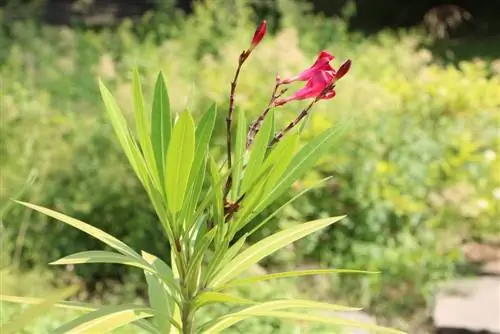
When the first strong frost hits the house, it is time for the oleander to move into winter quarters. The plant feels comfortable in different places during the cold season:
- in a cold house
- in the unheated stairwell
- in the greenhouse
- in unheated adjoining rooms
- in the winter tent
- in the cold winter garden
- in the basement
- in the garage
When choosing your winter quarters, it is important to take the location factors into account; The plant should have a bright place even in winter. This criterion is particularly met when overwintering in a cold house or in a cold winter garden. If the unheated stairwell is chosen as winter quarters, make sure it is close to a window. If you have to move to the basement or garage, the lighting conditions are usually less favorable; then it is important to adjust the wintering temperature accordingly.
Tip:
Basically, the darker the winter quarters, the lower the temperatures have to be.
The plant should be placed during the cold season at temperatures between two and ten degrees Celsius. If the temperatures are higher, there is a risk of pest infestation.
Alternatively, the lighting in the winter quarters can also be optimized. With the help of a cold-white fluorescent tube, the oleander is optimally supplied with light. Anyone considering artificial lighting should also consider using a lux meter to control the light energy. If the plant is overwintered at temperatures between 5 and 10°C, 1500 lx is optimal.
At higher temperatures, more intense lighting is necessary, which can be up to 3000 lx. However, permanent lighting should be avoided; the plant should be exposed to artificial light for a maximum of 10 hours per day. In addition, the day-night cycle must be observed.
Dangers of wintering indoors
If you move the oleander indoors during the cold season, you have to think about certain dangers - both for the plant itself and for those living with it. The most important dangers if the crop is protected over the winter include pest infestation, mold and certain diseases; The following stresses in particular cause problems for the oleander in winter:
- Aphids
- Spider mites
- Scale insects
- Oleander crab
In addition to choosing the optimal location, measures to ensure good ventilation of the winter quarters and weekly checks for pest infestation also help. If the plant is already infected, countermeasures should be taken quickly; Products based on potash soap or rapeseed oil are available to combat pests. Oleander canker, which is caused by a bacterium, can only be kept under control by cutting out the affected areas.
If you overwinter your oleander indoors, you should also remember that it is a poisonous plant. All parts of the plant contain the glycoside oleandrin, which is one of the toxic cardiac glycosides and must under no circumstances be consumed. Animals and small children should therefore not come near the plant.
Overwintering oleander outdoors - possible in selected regions
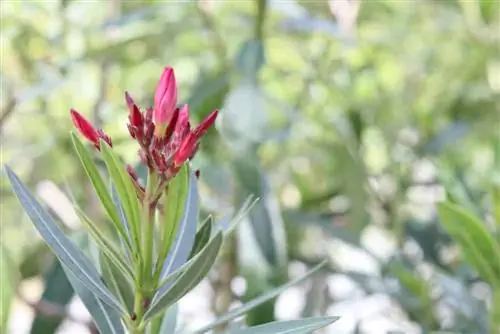
Oleander is partially hardy, but not completely winterproof. However, since it can withstand light frosts without any problems, it can also be hibernated outdoors; However, this only works in mild winter areas where no severe frosts are expected. In Germany this includes the following regions:
- the Ruhr area
- the coastal regions of the North Sea (including islands)
- the Lower Rhine
- the Moselle Valley
- the Rhine-Main area
Outdoor winter festival - protection for oleander plants
Wintering outdoors can take place in different locations; The balcony or terrace, which is sufficiently protected, is particularly popular. The oleander is placed in a large planter and then isolated. To achieve optimal floor insulation, the vessel can be placed on a Styrofoam plate, for example. However, the terrace is often also a popular place for other plants that are either hardy or only partially winter-hardy; To save space, it is a good idea to tie the oleander branches together with sisal cord.
The entire bucket is then wrapped with bubble wrap; Alternatively, a thick coconut mat can also be used. The leaves and shoots also need to be protected; This works best with an air-permeable hood made of plastic fleece. Burlap has also proven useful. However, completely airtight films should not be used as this can lead to mold infestation and rot.
Basically, it has proven useful to first attach the pot protection and only make the leaves and shoots winter-proof a few weeks later; This prevents an early, warm, humid climate in this area, which promotes the development of mold. The plant will still be “hardy” in time.
When overwintering the oleander outdoors, it is also important to ensure that the plant is given the most protected location possible; A place directly against the wall of the house is ideal; the balcony or terrace offers the advantage of an additional roof. Then the plant is optimally protected not only from the cold, but also from moisture.
Tip:
It has proven to make sense to place several pots next to each other so that the plants can warm each other. If very severe frosts are imminent, the bucket will be temporarily moved to the garage.
Oleander winter care - undemanding outdoors
If the oleander overwinters outdoors, it falls into hibernation. Then the overall care requirements are low. However, it is important that the winter protection is removed from time to time to ensure regular ventilation. Mold and moisture build-up should then no longer be a problem. Otherwise, the following aspects must be taken into account:
- Do not water
- Protect from moisture
- Do not supply nutrients
- Check winter protection in the pot area weekly
Higher care requirements indoors - winter quarters
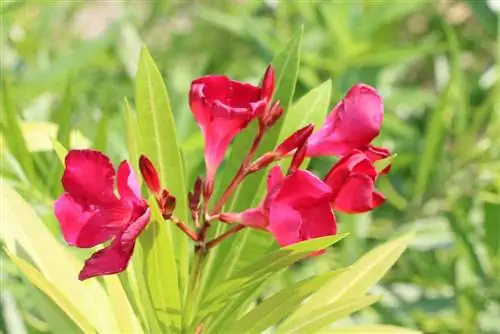
If the Mediterranean plant is overwintered indoors, the care measures must be expanded. Above all, regular checking of the plant for pests is important, as there are favorable living conditions for scale insects, spider mites, etc. in the winter quarters. Due to the dry air, they can multiply explosively. As a preventative measure, the plant should be sprayed with water more often.
Because the temperatures in the winter quarters are higher than outside, the oleander needs to be supplied with water from time to time. To determine if the plant needs moisture, you need to check the top half of the soil; If it is dry, it can be watered. This check works particularly well with the help of a moisture meter whose long probe can be inserted deep into the soil.
Complete the wintering period optimally
When the winter phase ends for the Mediterranean plant depends on various factors:
- from the weather conditions
- of the type of wintering
- from individual space requirements
If the oleander was allowed to overwinter outdoors, ending the overwintering period is particularly easy; In this case - depending on the weather - only protective fleeces, coconut mats and Styrofoam panels need to be removed. If the plant has been indoors during the cold season with temperatures up to a maximum of 10°C, it can be outdoors again in April.
Then it is still partially hardy, so it can tolerate light night frosts and low temperatures well. However, if the Mediterranean plant has been overwintered in a warm room, it may only be moved outside after the Ice Saints. Such plants have already formed new shoots in their winter quarters, which are then at great risk of frost.
It is important to gradually accustom the plants to the outdoor conditions. It has proven to be a good idea to put them in a shady spot for the first few days and then gradually increase the amount of light. Further care measures are then required; So should both repotting and pruning. Now there is sufficient watering, because the changed climatic conditions cause the oleander's pot ball to dry out quickly. The winter period finally ends when the crop is fertilized again for the first time in early spring.
Conclusion
Successfully overwintering the oleander is not complicated. If you pay attention to the site conditions and care measures, you can get the plant through the winter well and enjoy the colorful flowers next year.

